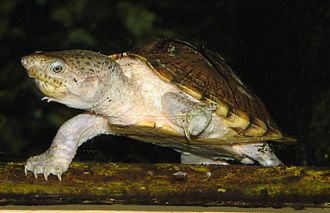Type the name of the breed you're looking for below
[wpdreams_ajaxsearchlite] Don't see the breed your're looking for? Click here and let us know!
Razor-Backed Musk Turtle
| Place of Origin and Range | It is found in the states of Oklahoma, Arkansas, Mississippi, Texas, Florida and Louisiana. |
| Description | It has a brown-coloured shell, with black markings at the edges of each scute. The shell has a distinct, sharp keel down the centre of its length, giving the species its common name. The body is typically grey-brown in colour, with black spotting, as is the head, which tends to have a bulbous shape to it. It has a long neck, short legs, and a sharp beak. Males can usually be distinguished from females by their longer tails. Barbels are present on the chin only. |
| Morph Patterns Available | Yes |
| Adult Size | Can grow up to 5in(13cm) |
| Accommodation | A filtered aquarium with water temperature at 70-80'F(21-26'C), and a sloping ramp(driftwood, textured plastic or some other non-abrasive surface) leading from the bottom to an illuminated and warmed basking spot. Approx 80'F(27'C). |
| Lifespan | Can live up to 30 years |
| Feeding / Diet | Their diets consist primarily of aquatic invertebrates, including freshwater clams, crayfish, snails, and various insects. They also feed on fish and carrion. |
| Breeding | They nest from September to June. The eggs, which are slightly over 2,5 cm (1 in) long, hatch 13 to 19 weeks later. The hatchlings are about the size of the end of a typical man's thumb and, unlike the adult turtles, have keeled carapaces. |
| Other Considerations | Watch for theses health concerns carefully with your turtle. Vitamin A Deficiency: Vitamin A is an important nutrient for your turtle’s health. It is found in his diet in the form of leafy green, orange or yellow vegetables, liver, and fish. If your turtle is not getting enough Vitamin A, he can suffer serious health problems. Always check to make sure that your turtle does not have swollen eyelids, as this is the main sign of a Vitamin A deficiency. Also, check for weight loss, nasal discharge and infected skin. Any of these symptoms could point to a deficiency. If you think your turtle may not be getting enough Vitamin A, you should take him to the veterinarian to get a firm diagnosis. Shell Problems: Your turtle’s shell is very important to his overall health. There are many potential problems that could occur, so you should be on the lookout at all times. Respiratory Disease: Respiratory infections have symptoms similar to vitamin A deficiency, including swollen eyelids and runny nose, so you should take your turtle to the veterinarian to get a proper diagnosis if you suspect either. More serious infections will be characterized by breathing through the mouth, mucus in the mouth, and wheezing. Always make sure your turtle’s environment has the proper amount of humidity, as this will help prevent respiratory problems. |



